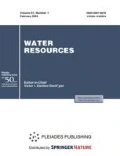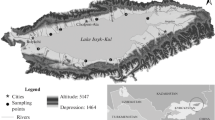Abstract
The studies of seasonal variations of some hydrochemical water characteristics (salinity, oxygen content, temperature, pH, and Eh) and the state of brine shrimp population in the typical hypersaline Lake Oiburg (Shtormovoe Vil., Crimea) have clearly shown their dependence on weather conditions. Variations have been established in the population size of brine shrimp, their life stages in the lake, as well as the extent of nauplii emergence from crustacean cysts (from 0.5% in March to 11.0% in February). Because of the ancient origin of Crimean hypersaline lakes (they number 45), which have formed 6500–7000 years ago, the processes taking place in them can be used to reconstruct the climatic and evolution events on the Earth in the distant geological epochs. The potential use of the annual dynamics of climatic, hydrochemical, and environmental characteristics of a salt lake in the model is discussed in the context of studying the effects of climate warming, the ensuing trends in the abiotic conditions in the water body, and their effect on biota.






Similar content being viewed by others
REFERENCES
Gulov, O.A., Ecoside of Crimean salt lakes, in Teoriya i praktika vosstanovleniya vnutrennikh vodoemov (Theory and Practice of the Recovery of Inland Water Bodies), St. Petersburg: Lema, 2007, pp. 60–78.
Khalafyan, A.A., Statistika 6 (Statistica 6), Ch. 8, Moscow: Biom, 2008.
Chaban, V.V., Application of Artemia salina bioindicator in ecological studies of salt lakes in the Crimea, Stroit. Tekhnogen. Bezop., 2012, no. 43, pp. 102–105.
Aljohny, B.O., Halophilic bacterium-a review of new studies (Review), Biosci. Biotechnol. Res. Asia, 2015, vol. 12.
Bradley, M., van Putten, I., and Sheaves, M., The pace and progress of adaptation: marine climate change preparedness in Australia’s coastal communities, Marine Policy, 2015, vol. 53, pp. 13–20.
Di Meglio, Santos, L., Gomariz, F., Almansa, M., López, C.C., Antón, J., and Nercessian, D., Seasonal dynamics of extremely halophilic microbial communities in three Argentinian salterns (Article), FEMS Microbiol. Ecol., 2016, vol. 92, Is. 12, Article number fiw184.
Edbeib, M.F., Wahab, R.A., and Huyop, F., Halophiles: biology, adaptation, and their role in decontamination of hypersaline environments (Review), World J. Microbiol. Biotechnol., 2016, vol. 32.
El-Magsodi, M.O., El-Ghebli, H.M., Hamza, M., Van Stappen, G., and Sorgeloos, P., Characterization of Libyan Artemia from Abu Kammash Sabkha, LibyanJ. Marine Sci., 2005, vol. 10, pp. 19–29.
Geldenhuys, Ch., Cotiyane, Ph., and Rajkaran, A., Understanding the creek dynamics and environmental characteristics that determine the distribution of mangrove and saltmarsh communities at Nahoon Estuary, South African J. Botany, 2016, vol. 107, pp. 137–147.
Glavaš, N., Šmuc, N.R., Dolenec, M., and Kovač, N., The seasonal heavy metal signature and variations in the microbial mat (petola) of the Sečovlje Salina (northern Adriatic), J. Soils and Sediments, 2015, vol. 15, no. 12, pp. 2359–2368.
Golan, R., Itta Gavrieli I., Ganor J., Lazarc B., Controls on the pH of hyper-saline lakes—A lesson from the Dead Sea, Earth Planet. Sci. Lett., 2016, vol. 434, pp. 289–297.
Guesdon, G., Santiago-Martin, A., Raymond, S., Messaoud, H., Michaux, A., Roy, S., and Galvez, R., Impacts of salinity on Saint-Augustin Lake, Canada: Water Remediation measures of watershed scale, Water (Switzerland), 2016, vol. 8, no. 7, Article no. 285.
Hargrave, B.T., Holmer, M., and Newcombe, C.P., Towards a classification of organic enrichment in marine sediments based on biochemical indicators, Mar. Pollut. Bull., 2008, vol. 56, pp. 810 –824.
Hetzel, Y., Pattiaratchi, C., Lowe, R., and Hofmeister, R., Wind and tidal mixing controls on stratification and dense water outflows in a large hypersaline bay, J. Geophys. Res.: Oceans, 2015, vol. 120, no. 9, pp. 6034–6056.
http://liveinsuccess.ru/voda-ph-eh-rh/
http://ribosite.ucoz.ru/publ/1-1-0-17
www.gismeteo.ru/.
IPCC. Report Fifth Assessment Report on Climate Change. Climate Change 2013: The Physical Science Basis. Contribution of Working Group I to the Fifth Assessment Report of the Intergovernmental Panel on Climate Change, Stocker, T.F., Qin, D., Plattner, G-K., Tignor, M., Allen, S.K., Boschung, J., Nauels, A., Xia, Y., V Bex, V., Midgley, P.M., Cambridge: Cambridge Univ. Press, 2013.
Kompaniets, L.A. and Iakubailik, T.V., Observations of hydrophysical characteristics of stratified salt lake Shira (Siberia) as an important part of environmental monitoring, 15th Int. Multidisciplinary Sci.GeoConf.SGEM 2015, 2015, pp. 635–641.
Li, L., Song, W., Deng, C., Zhang, D., Al-Misned, F.A., Mortuza, M.G., Gadd, G.M., and Pan, X., Effects of pH and salinity on adsorption of hypersaline photosynthetic microbial mat exopolymers to goethite: a study using a quartz crystal microbalance and fluorescence spectroscopy, Geomicrobiol. J., 2016, vol. 33, nos. 3–4, pp. 332–337.
Madeira, D., Araujo, J.E., Vitorino, R., Capelo, J.L., Vinagre, C., and Diniz, M.S., Ocean warming alters cellular metabolism and induces mortality in fish early life stages: a proteomic approach, Environ. Res., 2016, vol. 148, pp. 164–176.
Mitchell, S., Boateng, I., and Couceiro, F., Influence of flushing and other characteristics of coastal lagoons using data from Ghana, Ocean Coast. Manag., 2017, vol. 143, no. 1, pp. 26–37.
Sánchez, M.I., Paredes, I., Lebouvier, M., and Green, A.J., Functional role of native and invasive filter-feeders, and the effect of parasites: learning from hypersaline ecosystems, PLoS ONE, 2016, vol. 11, no. 8, Article number e0161478.
Schiedeck, D., Sundelin, B., Readman, J.W., and Macdonald, R.W., Interactions between climate change and contaminants, Marine Pollut. Bull., 2007, vol. 54, pp. 1845–1856.
Shadkam, S., Ludwig, F., van Vliet, T.H., Pastor, A., and Kabat, P., Preserving the world second largest hypersaline lake under future irrigation and climate change, Sci. Total. Environ., 2016, vol. 559, pp. 317–325.
Sirota, I., Arnon, A., and Lensky, N.G., Seasonal variations of halite saturation in the dead sea, Water Resour. Res., 2016, vol. 52, no. 9, pp. 7151–7162.
Van Stappen, G., Use of cysts, FAO Fisheries Technical Paper, 1996, no. 36, pp. 102–123.
Wooldridge, T.H., Adams, J.B., and Fernandes, M., Biotic responses to extreme hypersalinity in an arid zone estuary, S. Afr. J. Bot., 2016, vol. 107, pp. 160–169.
Funding
The study was carried out under the Governmental Order to the Institute of Biology of the Southern Seas, subject “Functional, Metabolic, and Toxicological Aspects of the Life of Aquatic Organisms and Their Populations in Biotopes with Different Physicochemical Regime,” State Registration АААА-А18-118021490093-4.
Author information
Authors and Affiliations
Corresponding author
Rights and permissions
About this article
Cite this article
Rudneva, I.I., Shaida, V.G. Seasonal Dynamics of the Hypersaline Lake Oiburg (Crimea) as a Model for Studying Climate Change Effects. Water Resour 47, 613–623 (2020). https://doi.org/10.1134/S0097807820040168
Received:
Revised:
Accepted:
Published:
Issue Date:
DOI: https://doi.org/10.1134/S0097807820040168




